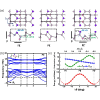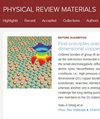Ferroelectricity and piezoelectricity in elemental α-X6 structure
IF 3.4
3区 材料科学
Q2 MATERIALS SCIENCE, MULTIDISCIPLINARY
引用次数: 0
Abstract
Two-dimensional (2D) elemental ferroelectricity has recently been confirmed and arouses great interest in exploring new elemental asymmetric structures and their symmetry-breaking related properties. In this study, our density functional theory (DFT) calculations reveal the existence of coupled in-plane and out-of-plane electric polarizations in the group elements (, As). These ferroelectric phases are stabilized through charge transfer between orbitals. The introduction of compressive strain facilitates the transformation from blue phosphorene into -P6 phase with low reaction energy owing to their structural similarity. In addition, strain engineering or atom substitution can effectively reduce the polarization switching barrier. Furthermore, structure exhibits large longitudinal piezoelectric strain coefficients , benefiting from their moderate and flexible character. This discovery not only enriches the family of elemental ferroelectrics but also deepens the understanding of the origin of elemental polarization, offering potential candidates for ferroelectric and piezoelectric applications.

元素 α-X6 结构中的铁电性和压电性
二维(2D)元素铁电性最近已得到证实,这引起了人们对探索新元素不对称结构及其对称破缺相关特性的极大兴趣。在本研究中,我们的密度泛函理论(DFT)计算揭示了 V 族元素 α-X6 (X=P、As)中存在面内和面外耦合电极化。这些铁电相通过 px 轨道间的电荷转移而稳定。由于二者结构相似,引入压缩应变可促进蓝色磷烯向 α-P6 相的转化,且反应能量较低。此外,应变工程或原子置换可有效降低极化转换障碍。此外,α-X6 结构表现出较大的纵向压电应变系数 d11,这得益于其适中的 e11 和柔性特征。这一发现不仅丰富了元素铁电家族,而且加深了人们对元素极化起源的理解,为铁电和压电应用提供了潜在的候选材料。
本文章由计算机程序翻译,如有差异,请以英文原文为准。
求助全文
约1分钟内获得全文
求助全文
来源期刊

Physical Review Materials
Physics and Astronomy-Physics and Astronomy (miscellaneous)
CiteScore
5.80
自引率
5.90%
发文量
611
期刊介绍:
Physical Review Materials is a new broad-scope international journal for the multidisciplinary community engaged in research on materials. It is intended to fill a gap in the family of existing Physical Review journals that publish materials research. This field has grown rapidly in recent years and is increasingly being carried out in a way that transcends conventional subject boundaries. The journal was created to provide a common publication and reference source to the expanding community of physicists, materials scientists, chemists, engineers, and researchers in related disciplines that carry out high-quality original research in materials. It will share the same commitment to the high quality expected of all APS publications.
 求助内容:
求助内容: 应助结果提醒方式:
应助结果提醒方式:


